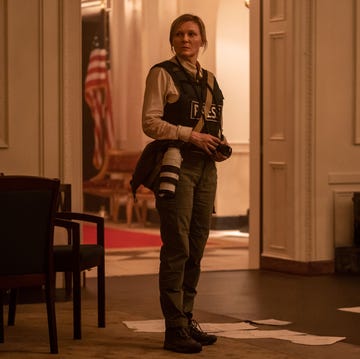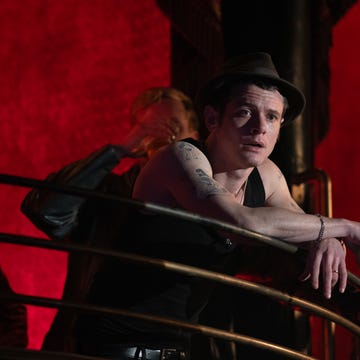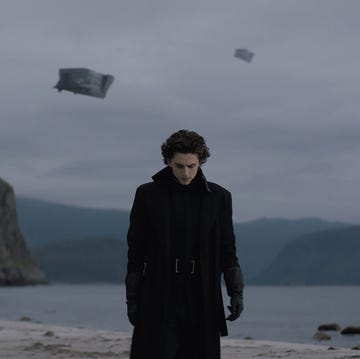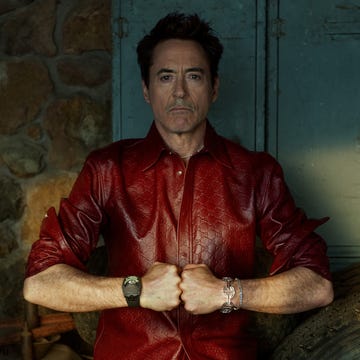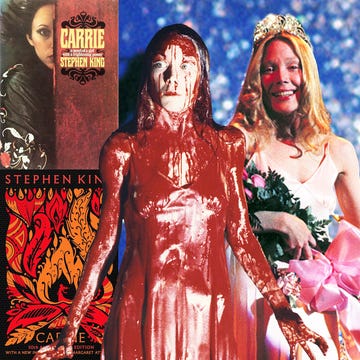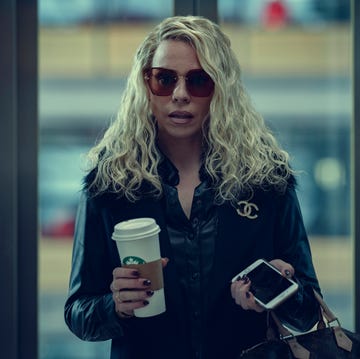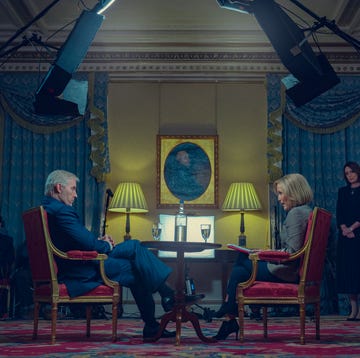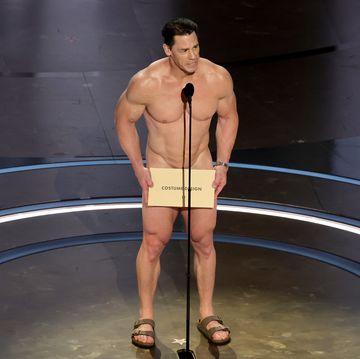1 | Meanings
A | Mulholland Dr, a street-sign pertaining to the rolling, twisting road that follows the mountain ridge to the north of Los Angeles and which reaches nearly 50 miles, from just northwest of downtown to the Pacific Ocean. Going west, the first stretch is a made-up road, but then it turns into dirt.
Though dangerous for driving because of its many blind curves, the road is celebrated for its immense views — of the city to the south, at night like a jewellery case spilled in neon, etc; to the north, of the dense and overheated San Fernando Valley (the place where the porn industry operates); to the west, of the infinite Pacific; and sometimes to the east, the dusty shimmer of the desert that separates Los Angeles from the rest of the US.
The road has many stately mansions (Marlon Brando and Jack Nicholson) and many abandoned shacks where you may find traces of love trysts, drug deals and the gathering of gangs like those of Charles Manson. Wildlife: eagles, coyote, feral cats, deer, snakes and wilder still.
The street is named for William Mulholland (1855–1935), the LA superintendent of water and power, the engineer who carried out the transit plan that brought drinkable water and blue pools from the Owens Valley and the Sierra to the city. This is the history that lies behind the film Chinatown.
B | Mulholland Dr, the 2001 film by David Lynch, very well reviewed in its time, but of growing authority and reputation.
Why? Essentially, because it is a mystery film that never settles its own mystery. Even its greatest admirers are loathe to explain it or endure it being explained.
Here is a film in which the attitude to the world opts for fatal atmosphere instead of resolution.
Still, it is regarded as a monument to something (it did open in October 2001), including the death and ghostly afterlife of the picture business and the forlorn attempt of so many pretty girls to reach the screen and be as important as the water.
C | Is the film’s title “Mulholland Drive” or “Mulholland Dream”? Can’t it be both? After all, so many figures in the film have more than one name, and persona. (Clue: if you like Mulholland Dr, take a look at Ingmar Bergman’s Persona, made in 1966.)
2 | Personae
A | Betty (Naomi Watts), from Deep River, Ontario, who comes to Los Angeles to be in the movies.
She is so pretty and hopeful, and so old-fashioned at first, she is slightly stupid. This is important because it means you can’t really like her or identify with her. (Clue: there are no people in this film we can love or trust.)
She is Betty Grable; she could be Betty Bacall (without her sourness); she might have been Bette Davis (with some added arrogance). She is Betty Boop in pink and grey and live action. And she is good! She could have gone all the way!
When she does her audition, with the absurdly tanned and ossified Chad Everett as Jimmy “Woody” Katz, she wows everyone, she puts his hesitant hand on her ass, and she stops the show. Not that there is going to be a show, because the wretchedly amiable Wally (James Karen), the would-be producer at the audition, is never going to get his picture set up.
That’s what we learn from the top-notch casting agent who is there, the one who scoops up Betty for a shot at The Sylvia North Story (a “real” picture). She ought to know — she was married to Wally once. Romance-wise, LA is a city of the walking wounded where sometimes you have to stop to remember whom you’ve fucked.
B | The brunette (Laura Harring). Beautiful, sultry, voluptuous, but with more than a hint of a noir B-picture dame (or even the San Fernando route).
While being driven on Mulholland at night, she is in a car accident. Concussed or dreaming, she staggers down the steep hill in her cocktail dress and takes refuge in an apartment complex.
She hides in the apartment owned by Betty’s aunt (an actress away on a movie), so when Betty gets in and thinks the place is heaven she finds the brunette naked in the shower, but not showering. Betty is so sweet and stupid, she doesn’t call the police. She says, oh, of course, what’s your name?
The brunette doesn’t know — after all, early in a film, especially some films, when she hasn’t read the script yet, an actress may not know the name of her character. But the brunette notices a poster on the wall for Gilda (1946) and decides her name is “Rita” (look it up if you don’t know!).
C | Camilla Rhodes (Melissa George). A bland cutie-pie, with a touch of Debbie Reynolds and Sandra Dee, plus a lot of pink and a knowing look. What might she know? That, despite her old-hat cliché audition (she sings a bouncy “I’ve Told Every Little Star”), sounding like the Fifties, she is going to get the part in The Sylvia North Story, but...
D | Adam Kesher (Justin Theroux), the director of TSNS, is still looking for another actress; and he will see Betty from afar, and he knows, when they give each other that look, that long, loving look (you know the look — you’ve practised it in the mirror), he just knows it should be Betty.
But the mysterious and rather menacing powers that be, personified by The Cowboy (Monty Montgomery), tell him it has to be Camilla Rhodes. The fix is in, and they’ll put Adam out of business — they’ll shut him down — if he doesn’t play ball.
So when Camilla does her audition, Justin musters and balances his integrity and his fear (he is a director), and says, “This is the girl.” Poor Betty, who is watching, is crushed.
E | And don’t forget Diane Selwyn, who isn’t exactly played by anyone, except as a corpse curled up on a bed, her face in shadow, but with the grey sheen of decomposition on her thighs.
You see, “Rita” thinks maybe her name is Diane. She sees a waitress in a Winkie’s with the name tag, “Diane”, and a bell goes off. She thinks she might be “Diane Selwyn”. (Selwyn is an old movie name: long ago, an Edgar Selwyn went into partnership with Samuel Goldfish, and Sam said, “We gotta be Goldwyn!” It was cooler than Selfish or Sell Fish.)
Like girl detectives, Betty and “Rita” track down Diane Selwyn and find her dead on the bed. This is upsetting.
F | And in upset, roles and names get switched: Betty becomes Diane, and her glow turns lacklustre. She looks older, much sadder; she seems ill, or drugged (“Mulholland Drug”?) and disillusioned by the dream of becoming a movie star.
But Rita/Diane becomes Camilla, the star of TSNS and Adam’s squeeze. It looks as if they have a big announcement! This really pisses Betty off now that she’s Diane. So she hires the thug Messing (Mark Pellegrino), who has been in and out of the film, to murder Camilla.
But before this can be carried out, Betty/Diane goes back to her rotten place — it seems to stink of her corpse already — and starts to have hallucinations. It’s all too much for her and there is a gun handy.
I’d like to say a little bit about those hallucinations. When Betty arrives at the airport, LAX, she seems to have met Irene (Jeanne Bates) on the plane, a standard issue friendly old lady. There is a man with her and in farewell they give Betty all kinds of platitudinous good wishes, good luck and “take care”. It seems like routine small talk, but then there’s a shot of the older couple in the back of their cab being driven away.
It may be as frightening as any moment in this scary film. For they are laughing, in glee, though without the sound of laughter. It’s not cheery mirth, as if to say, “What a lovely girl that was!” No, it’s far more unkind and gloating, driven by the feeling, “What an idiot! Is she in for it, or what?” These two seem to guess how it must all turn out, and they are like Furies in a classical drama who know that Betty is on her way to being a corpse.
At the very end, Betty’s hallucinations see miniature versions of this couple — like worms, or maggots — crawling under her closed door, still laughing, ready to feed on her.
This couple are true to the backdrop of Lynch’s film.
When Betty goes for her audition, she faces a room crammed with guarded, stilted voyeurs. Wally is trying to be friendly; Woody wants to be urbane; the director searches in vain for some pretentious advice.
On the surface, they’re nice to Betty, but niceness has decayed in this world. They are waiting like ambushers to see how far Betty will go — whether she’ll put Woody’s hand on her ass; how much she sighs at the kissing; how hot or exposed she can be. And that’s what your friends are like.
Then there are the underworld figures, the Castigliani brothers (Angelo Badalamenti — the film’s composer — and Dan Hedaya), one calm, one furious, the dwarf in the wheelchair who does the phone calls, not to mention The Cowboy, who looks absurd in his 10-gallon hat but carries the menace that is never far away in Lynch’s world. When Adam directs, he seems intent on seducing Camilla — isn’t that what films are for, and why directors stay seated?
Then there’s the hoodlum, Messing, who goes to collect a black book that holds all the dark secrets (not the script, but the deal contract) and shoots the man who has it.
But in trying to make this killing look like suicide, he accidentally shoots the wall. The bullet goes through the wall and hits a very fat woman in the next room. When Messing goes to see the damage, the outraged woman attacks him, so he has to finish her off.
But the janitor sees this, so he has to shoot the janitor, too. In the process, the janitor’s vacuum cleaner starts up. So our guy has to shoot the vacuum! It’s a good thing these guns have enough bullets.
This scene is grotesque, cruel yet comic, and it’s a warning that the threats in the film aren’t just actors mouthing lines. There is a monster behind the Winkie’s and Diane’s body was rotting.
Even Coco Lenoix, the manager of the apartment complex (1612 Havenhurst), seems amiable at first, doing what she can to be welcoming to Betty. Of course, Coco is Ann Miller, and you can believe she’d do a quick bit of tap in the courtyard if there wasn’t dog shit there. But then at the party, Coco seems to realise that it’s good night Diane.
She’s been around. She’s seen it all happen before with the fresh-faced girls in pink who came to Hollywood from wherever it was and found a sticky end.
There are a few helicopter shots of the HOLLYWOOD sign in the film, enough to make you recall that the young English actress Peg Entwistle jumped off the “H” in 1932 and killed herself. Or was she thrown? Was it a little bit more sinister? Was there a criminal organisation deciding which starlets made it even then? And which ones had their big scenes in the morgue?
Once upon a time an impressionable literary-minded observer noted that Mulholland Drive might be the body of Marilyn Monroe stretched out on the mountain ridge. Whatever next! He saw her platinum hair as the surf at the Leo Carrillo Park beach beyond Malibu. And Marilyn is the ultimate Hollywood blonde; she was born and died there; she found her glory and her disappointments there.
One of the ways Betty seems a dumb blonde is the archaic Fifties eagerness she brings to Los Angeles. Lynch starts with an intricate series of layered images — like a series of screens. It shows the jitterbug contest that Betty won in Canada that got her to Hollywood!
And her shining face — as radiant as Doris Day, but with an innocence that is pure Naomi Watts (I don’t think Doris ever had such hopeful eyes) — is superimposed on it all. She wants to see and be seen. But at the last party it’s her paranoia and horror that dreads the way people are looking at her — when her looks are gone and the illness called failure is terminal.
If you compare this with Lynch’s other masterpiece, Blue Velvet (1986), it’s striking to see how far his heroic optimism has been crushed. Blue Velvet has some very disturbing scenes, from the severed ear to Frank’s raging madness and Dean Stockwell’s suave rendering of “In Dreams”.
It subjects its young hero, Jeffrey (Kyle McLachlan), to voyeurism and sexual initiation; he wants those things, but he dreads growing up. And Jeffrey and his girl, Sandy (Laura Dern), are true blue and straight out of Teen Romance. What’s more, they solve their case. They are going to be all right, the bad guys are dead, and even Dorothy Vallens (Isabella Rossellini) has a chance if she keeps on her medication. By contrast, Mulholland Dr is a panorama of decomposition and ruin.
Yes, Camilla gets the part and she may get Adam, too. But we know already what a jerk Adam is. That’s why his wife, Lorraine, was fucking someone else in the middle of the day. That’s when, in pique, Adam pours pink paint into her jewellery box — great scene. Camilla actually looks dead already, or like a lifesize cut-out sitting in the car with Adam.
What I’m suggesting is that, while this film was released by Universal, cost about $15 million and grossed a good deal more, and also earned Lynch an Academy Award nomination as best director, it’s filled with hatred for the Hollywood movie and the way it has abused so many Bettys in its time.
It’s a great film, but it’s a get-me-out-of-here experience. And even great films have holes or flaws, especially mysteries that aren’t going to be explained. For instance, if Lynch really feels so mortified for the Betty brigade, isn’t it old Hollywood — Wally style, if you like — to have Naomi Watts and Laura Harring naked and getting it on? Now, I can understand that Universal and the producers said, well, why not, if it’s $15 million? There’s part of me that feels ungrateful for all we get to see. There’s only so much critical integrity can do to “place” naked bodies.
But I think I want more or less. Either they have a serious affair and go down on each other — and big actresses don’t expect to have to do that (that’s San Fernando Valley) — or you just feel the desire and the longing, the way we get the look between Betty and Adam. So it was a money scene, and maybe David Lynch despised himself for doing it, while Naomi Watts asked herself why she’d come all this way if she wasn’t ready to slip out of her robe.
My other give-it-a-miss scene may surprise you: it’s the visit to the Silencio club, where the girls watch Rebekah Del Rio sing, collapse and be carried off the stage while the song goes on.
The master of ceremonies has warned us that everything is an illusion, but to be honest I got that about this movie at “Hello”. There’s always been a strange mix of poetic mystery and the crushingly obvious in Lynch. It’s sweet, but he should never try to explain himself. Nothing against Ms Del Rio or her make-up, and the MC (Geno Silva) is in my Top 10 MCs, but it’s an overrated classic.
3 | Two Last Things, Dead Women
A | The film is dedicated to Jennifer Syme (1972–2001). All I know about her is that she was a friend of Lynch’s, who wanted to be an actress. She had a scene in Lynch’s film Lost Highway, and was killed in a car crash in Los Angeles as Mulholland Dr was being made.
B | Yvette Vickers. In April 2011, her body was found by a neighbour in her cottage on Benedict Canyon. Ms Vickers was said to be 82 (born in 1928) and she may have been dead for a year.
She’d had her moment: she was Playboy playmate of the month in July 1959, she had a big role in Attack Of The 50-Foot Woman (1958) and she had a bit part in 1950’s Sunset Boulevard (she is the girl on the phone when Joe Gillis — played by William Holden — wants to make a call at the party). Yvette Vickers was in that house dead for months (it reached 113 degrees during that time).
The neighbour only got worried when she saw mail spilling out of the box. It can happen.
Sunset Blvd, the road, figures briefly in Mulholland Dr, but the two films are parallels in an interesting way. In the 1950 picture, Joe Gillis strays into the house of Norma Desmond. He is hired for his help, as screenwriter and companion, but Norma has to shoot him finally when he demands his freedom.
In Mulholland Dr, Betty arrives at aunt Ruth’s apartment, but she is forestalled. The woman to be named later — Rita, then Camilla — is there already, and she is a witch who will not let Betty go, or allow Betty to be Camilla.
Already, Mulholland Dr is over 20 years old, and I think it’s widely regarded as one of the best films of the new century.
I would not be surprised if it becomes regarded as one of the “greatest” films ever made. It is full of mixed feelings for Los Angeles, but it surely marks a sense of despair over the old mainstream movies that were Hollywood. I’m not sure if anything in the horror genre is as disconcerting as what we see of Naomi Watts once she has become Diane Selwyn.
It is not just an actress without make-up... it’s a spirit afflicted by plague.
Clearer now?






